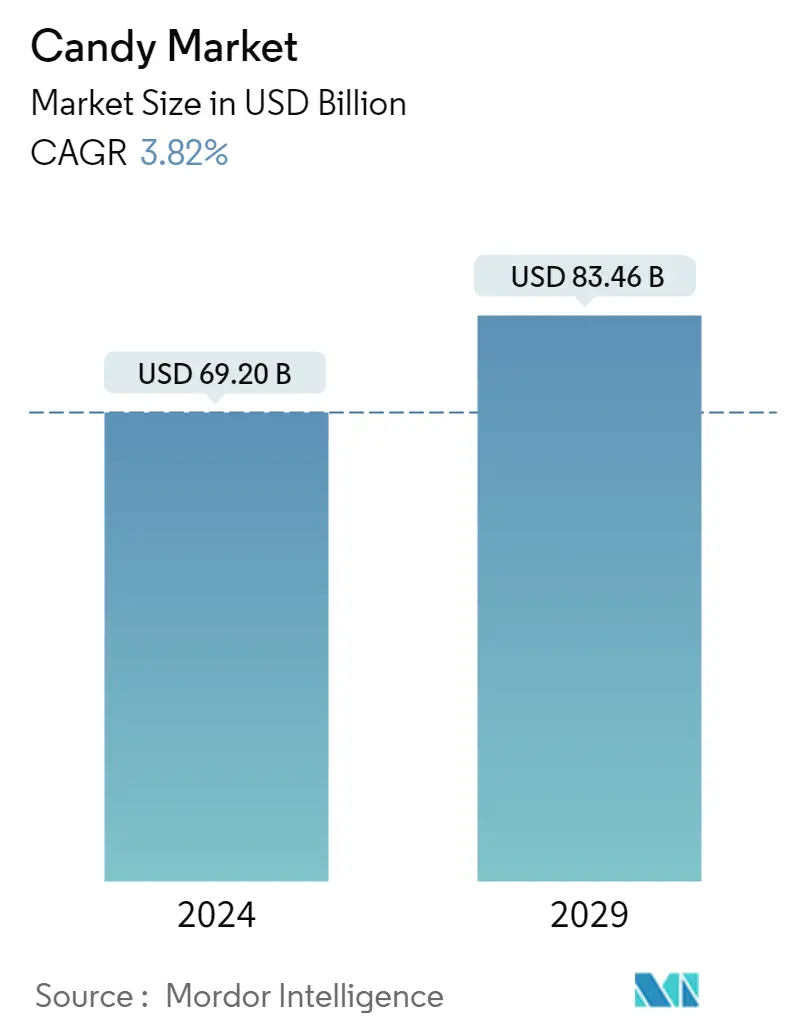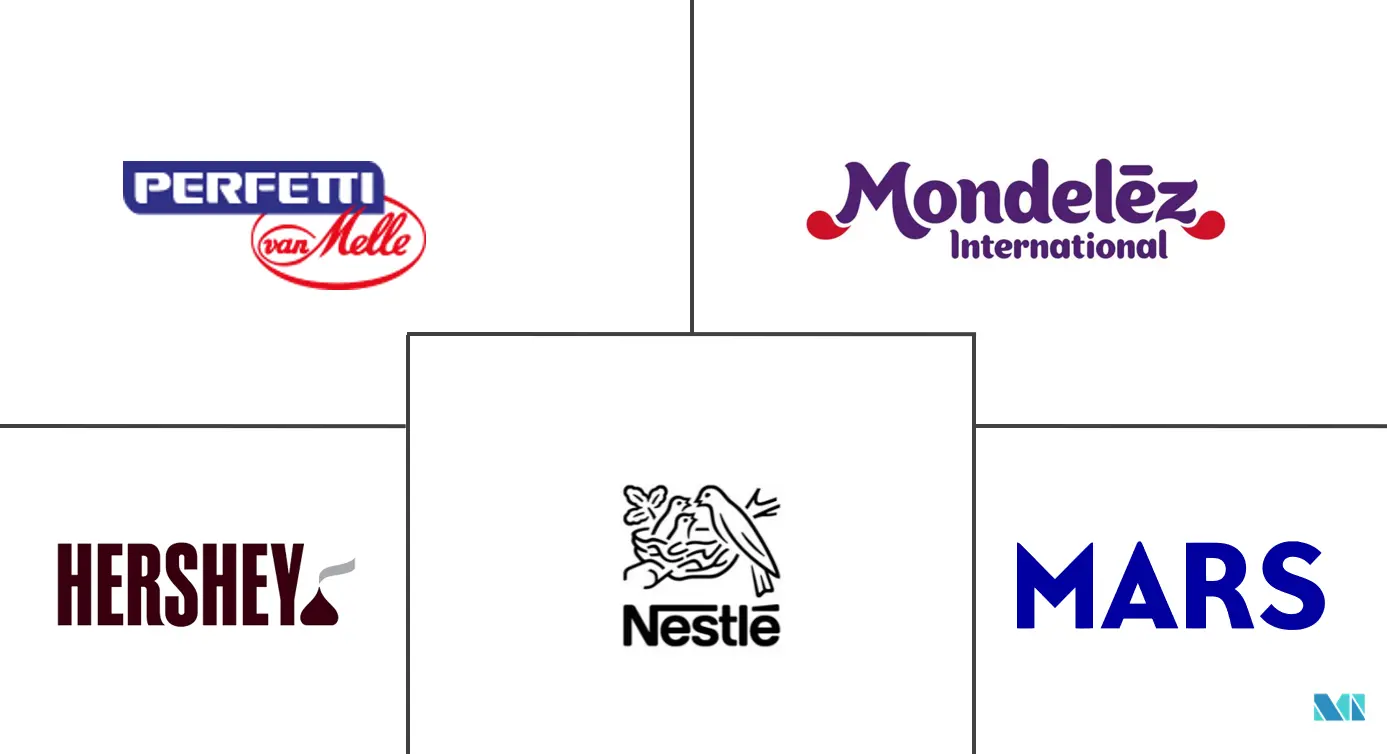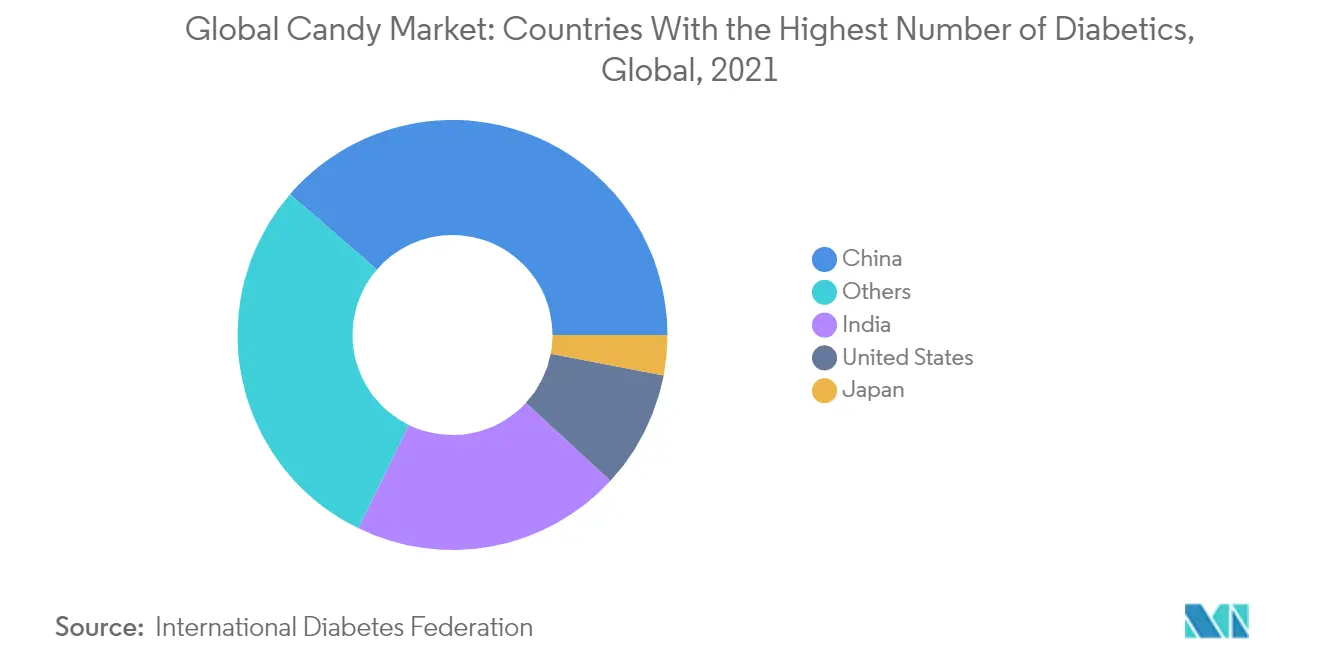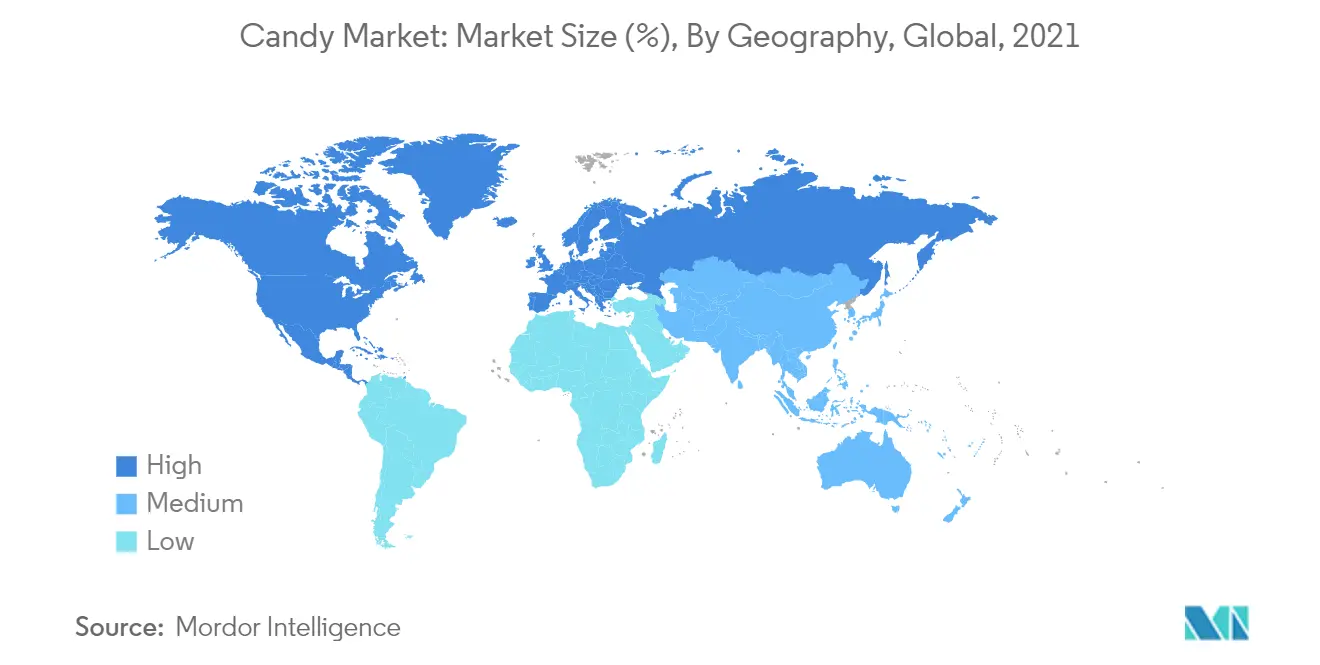Candy Market Size

| Study Period | 2019 - 2029 |
| Market Size (2024) | USD 69.20 Billion |
| Market Size (2029) | USD 83.46 Billion |
| CAGR (2024 - 2029) | 3.82 % |
| Fastest Growing Market | Asia Pacific |
| Largest Market | Asia-Pacific |
Major Players
*Disclaimer: Major Players sorted in no particular order |
Candy Market Analysis
The Candy Market size is estimated at USD 69.20 billion in 2024, and is expected to reach USD 83.46 billion by 2029, growing at a CAGR of 3.82% during the forecast period (2024-2029).
Over the last year, the coronavirus has impacted every industry, including the confectionery and candy industry, although only for the short term. Early sales data of the candy market across the globe registered a steep decline in the gums and mint category as a result of COVID-19 while chocolate candy, as well as non-chocolate candy, continued to attain strong growth. COVID-19 also brought massive changes to the retail side of the candy industry. More consumers started online ordering for groceries, ranging from click-and-collect to home delivery. The Hershey Company stated that its e-commerce sales were up significantly, with a growth of over 120% in March 2020, versus 60% in January 2020 and February 2020.
Candy products have acquired a prominent place in households across the globe due to COVID-19 lockdown implementations and lockdown extensions. The preference for sweet indulgence has increased due to more consumers working from home, with consumers opting for candies as a small snack. Furthermore, the change in traditional patterns of food consumption may also open a pathway for innovation across the candy market across the globe as countries are recovering from the impact of the global pandemic.
This increase in candy market value may be linked to a number of causes, including increased product innovation by key companies, an ever-increasing population of young and children, and rising personal disposable income. The key elements driving the expansion of the confectionery market are rising westernisation, modernisation, and personal disposable income. Other indirect candy market growth variables include an ever-increasing youthful population, the growth and expansion of the confectionery sector, and the growing popularity of dark chocolate. Consumers' impulsive behaviour has pushed producers to increase the availability of various candies on a huge scale in the market.
Candy Market Trends
This section covers the major market trends shaping the Candy Market according to our research experts:
Rising Demand for Sugar-free Candies
Due to increased health consciousness and desire for non/low-sugar chocolates/confectionery items, sugar-free candies have gained commercial momentum in recent years. The main explanation for the rise in demand for sugar-free confectionery among the general public is an increase in the number of diabetic people, According to data from the International Diabetes Federation, currently, 537 million individuals (20-79 years old) have diabetes. By 2030, there will be 643 million diabetics worldwide, and by 2045, there will be 783 million. These alarming numbers are expected to push the sales of Sugar-free candies globally.
Sugar-free candies are observing high growth in the global market, owing to the recent developments in the candy flavors, their appearance, and their mouthfeel. The majority of the manufacturers are focusing on product development in line with the organic food culture across the world. Further, due to constant emphasis on clean-labeled products and stricter government regulations on the amount of sugar content in food products, organic, vegan, GMO-free, and kosher food colors, sweeteners, and other ingredients are being used to manufacture sugar-free candies, which are likely to contribute to the growth of the category.

Asia Pacific Holds the Largest Share
The Asia Pacific region dominates the candy market and is expected to continue to do so over the projected period, with China and India emerging as the major markets for candy. This is due to the increased popularity of chocolate-based confectionery goods, the existence of significant players, and the main companies' increasing product introductions.
The growing population in the region has led to a high demand for candies, fueled by the impulsive purchase behavior of consumers. Many countries like India, China and Japan are witnessing campaigns and media advertisements related to innovative candy products, which are directly impacting the sales rate of sugar-based confectionery. Companies are increasingly launching products with innovative flavors such as raw mango, tamarind, and strawberry, among others, to attract consumers in these emerging markets. The candy Market in India is growing at the fastest rate in the region, where manufacturers are integrating new technologies and expanding production facilities have had a favorable influence on total demand growth.

Candy Industry Overview
Based on the nature of the market, the global candy market is very competitive and is marked by the presence of a large number of domestic companies capturing a prominent share in the market. Some of the prominent players include Perfetti Van Melle Group BV, Mondelez International Inc., Mars Incorporated, and The Hershey Company, among others. Owing to the rapidly developing nature of the market, launching a new product has become one of the most important strategies to gain a competitive edge. The players in the market have also been adopting expansion as a key strategy, followed by mergers and acquisitions. These strategic moves have proven to be successful for global players seeking to strengthen their presence in the market.
Candy Market Leaders
-
The Hershey Company
-
Nestle SA
-
Perfetti Van Melle Group B.V.
-
Mondelez International, Inc.
-
Mars, Incorporated
*Disclaimer: Major Players sorted in no particular order

Candy Market News
- In May 2022, Push Pop Gummy Pop-its were introduced by Bazooka Candy Brands. This year's Sweet & Snacks Expo in Chicago will feature the newest gummy innovation. Push Pop Gummy Pop-its, which debuted under the Push Pop brand, combine gummies with an interactive, refillable container.
- In May 2022, Bazooka Candy Brands launched Push Pop Gummy Pop-its. The new Push Pop Gummy Pop was launched in three flavors, including strawberry, blue raspberry, berry blast, and watermelon.
- In March 2022, HARIBO unveiled a lineup of Easter treats and claimed that it is sure to please any fan of gummy candy. The company announced that it was bringing back 'previous favorites', along with debuting two new products. The launched products include Jelly Bunnies and Chick 'n' Mix.
Candy Market Report - Table of Contents
1. INTRODUCTION
- 1.1 Study Assumptions and Market Definition
- 1.2 Scope of the Study
2. RESEARCH METHODOLOGY
3. EXECUTIVE SUMMARY
4. MARKET DYNAMICS
- 4.1 Market Drivers
- 4.2 Market Restraints
-
4.3 Porter's Five Forces Analysis
- 4.3.1 Threat of New Entrants
- 4.3.2 Bargaining Power of Buyers/Consumers
- 4.3.3 Bargaining Power of Suppliers
- 4.3.4 Threat of Substitute Products
- 4.3.5 Intensity of Competitive Rivalry
5. MARKET SEGMENTATION
-
5.1 By Type
- 5.1.1 Chocolate Candy
- 5.1.2 Non-chocolate Candy
- 5.1.2.1 Hard Boiled Candies
- 5.1.2.2 Pastilles, Gums, Jellies, and Chews
- 5.1.2.3 Toffees, Caramels, and Nougat
- 5.1.2.4 Mints
- 5.1.2.5 Other Non-chocolate Candies
-
5.2 By Distribution Channel
- 5.2.1 Supermarkets/Hypermarkets
- 5.2.2 Convenience Stores
- 5.2.3 Specalist Retailers
- 5.2.4 Online Retail
- 5.2.5 Other Distribution Channels
-
5.3 Geography
- 5.3.1 North America
- 5.3.1.1 United States
- 5.3.1.2 Canada
- 5.3.1.3 Mexico
- 5.3.1.4 Rest of North America
- 5.3.2 Europe
- 5.3.2.1 Germany
- 5.3.2.2 United Kingdom
- 5.3.2.3 France
- 5.3.2.4 Russia
- 5.3.2.5 Italy
- 5.3.2.6 Spain
- 5.3.2.7 Rest of Europe
- 5.3.3 Asia-Pacific
- 5.3.3.1 India
- 5.3.3.2 China
- 5.3.3.3 Australia
- 5.3.3.4 Japan
- 5.3.3.5 Rest of Asia-Pacific
- 5.3.4 South America
- 5.3.4.1 Brazil
- 5.3.4.2 Argentina
- 5.3.4.3 Rest of South America
- 5.3.5 Middle-East and Africa
- 5.3.5.1 United Arab Emirates
- 5.3.5.2 South Africa
- 5.3.5.3 Rest of Middle-East and Africa
6. COMPETITIVE LANDSCAPE
- 6.1 Most Active Companies
- 6.2 Market Share Analysis
- 6.3 Strategies Adapted by Leading Companies
-
6.4 Company Profiles
- 6.4.1 Perfetti Van Melle Group BV
- 6.4.2 Mondelez International Inc.
- 6.4.3 Mars Incorporated
- 6.4.4 Haribo GmbH & Co. KG
- 6.4.5 Nestle SA
- 6.4.6 The Hershey Company
- 6.4.7 Ferrero Group
- 6.4.8 Cloetta Ab
- 6.4.9 Grupo Arcor
- 6.4.10 The Topps Company Inc.
- *List Not Exhaustive
7. MARKET OPPORTUNITIES AND FUTURE TRENDS
8. IMPACT OF COVID-19 ON THE MARKET
** Subject To AvailablityCandy Industry Segmentation
Candy, often known as sweets or lollies, is a sweet confection made primarily of sugar. Any sweet confection including chocolate, chewing gum, and sugar candy, falls under the genre of sugar confectionery. The global candy market is segmented by Type, Distribution Channel, and Geography. Based on type, the candy market is segmented into Chocolate candy and Non-chocolate candy. The Non-chocolate candy segment is further segmented into Hard-boiled Candies, Pastilles, Gums, Jellies, Chews, Toffees, Caramels, Nougat, Mints, and other Non-Chocolate Candies. The other types of Non-chocolate candies include Licorice, Lollipops, and Medicated confectionery. Based on Distribution Channels, the market is segmented into Supermarkets/Hypermarkets, Convenience stores, Specialist Retailers, Online retail, and Other Distribution channels. To provide a broader perspective, the market is studied for potential and promising countries across different regions including North America, Europe, Asia-Pacific, South America, Middle-East, and Africa. For each Segment, the market sizing and forecasts are carried out based on value (in USD millions).
| By Type | Chocolate Candy | |
| Non-chocolate Candy | Hard Boiled Candies | |
| Pastilles, Gums, Jellies, and Chews | ||
| Toffees, Caramels, and Nougat | ||
| Mints | ||
| Other Non-chocolate Candies | ||
| By Distribution Channel | Supermarkets/Hypermarkets | |
| Convenience Stores | ||
| Specalist Retailers | ||
| Online Retail | ||
| Other Distribution Channels | ||
| Geography | North America | United States |
| Canada | ||
| Mexico | ||
| Rest of North America | ||
| Geography | Europe | Germany |
| United Kingdom | ||
| France | ||
| Russia | ||
| Italy | ||
| Spain | ||
| Rest of Europe | ||
| Geography | Asia-Pacific | India |
| China | ||
| Australia | ||
| Japan | ||
| Rest of Asia-Pacific | ||
| Geography | South America | Brazil |
| Argentina | ||
| Rest of South America | ||
| Geography | Middle-East and Africa | United Arab Emirates |
| South Africa | ||
| Rest of Middle-East and Africa |
Candy Market Research FAQs
How big is the Candy Market?
The Candy Market size is expected to reach USD 69.20 billion in 2024 and grow at a CAGR of 3.82% to reach USD 83.46 billion by 2029.
What is the current Candy Market size?
In 2024, the Candy Market size is expected to reach USD 69.20 billion.
Who are the key players in Candy Market?
The Hershey Company, Nestle SA, Perfetti Van Melle Group B.V., Mondelez International, Inc. and Mars, Incorporated are the major companies operating in the Candy Market.
Which is the fastest growing region in Candy Market?
Asia Pacific is estimated to grow at the highest CAGR over the forecast period (2024-2029).
Which region has the biggest share in Candy Market?
In 2024, the Asia-Pacific accounts for the largest market share in Candy Market.
What years does this Candy Market cover, and what was the market size in 2023?
In 2023, the Candy Market size was estimated at USD 66.65 billion. The report covers the Candy Market historical market size for years: 2019, 2020, 2021, 2022 and 2023. The report also forecasts the Candy Market size for years: 2024, 2025, 2026, 2027, 2028 and 2029.
What are the challenges faced by the Global Candy Industry?
The challenges faced by the Global Candy Industry are a) Rising sugar prices b) Health consciousness c) Competition from substitutes
Candy Industry Report
The candy industry is witnessing steady expansion, driven by rising consumer demands for premium and health-conscious products across chocolates, gummies, and more, catering to diverse age groups and preferences from economy to luxury segments. With a strategic focus on healthier choices, the industry sees a shift towards candies made with organic and natural ingredients. Advances in e-commerce have prompted candy companies to evolve their product offerings to include sugar-free and fortified options, broadening their market reach. Additionally, innovative packaging designs are being developed to enhance customer experience and appeal. Statistics from industry reports highlight significant growth in the candy market, emphasizing the importance of adapting to consumer preferences and tapping into emerging market dynamics. For a detailed candy market analysis and forecast, tools like Mordor Intelligence™ provide comprehensive insights and future outlooks, essential for industry players looking to strategize effectively. Get a sample of this industry analysis as a free report PDF download.



